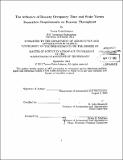| dc.contributor.advisor | R. John Hansman. | en_US |
| dc.contributor.author | Kolos-Lakatos, Tamás | en_US |
| dc.contributor.other | Massachusetts Institute of Technology. Department of Aeronautics and Astronautics. | en_US |
| dc.date.accessioned | 2014-03-19T15:46:30Z | |
| dc.date.available | 2014-03-19T15:46:30Z | |
| dc.date.copyright | 2013 | en_US |
| dc.date.issued | 2013 | en_US |
| dc.identifier.uri | http://hdl.handle.net/1721.1/85804 | |
| dc.description | Thesis: S.M., Massachusetts Institute of Technology, Department of Aeronautics and Astronautics, 2013. | en_US |
| dc.description | Cataloged from PDF version of thesis. | en_US |
| dc.description | Includes bibliographical references (pages 107-109). | en_US |
| dc.description.abstract | Air traffic growth in the U.S. has led to runway capacity constraints in the air transportation network. There has been limited new construction of runways due to land availability. One approach to increase capacity of existing runways is to reduce inter-arrival separations during the final approach phase of flight. This study evaluates two major elements influencing runway capacity; runway occupancy and wake vortex separation, and under what conditions each becomes a constraint to runway capacity. A detailed analysis of runway occupancy time measurements and wake vortex separation measurements is performed for Boston, Philadelphia, New York La Guardia, and Newark airports based on Airport Surface Detection Equipment Model-X (ASDE-X) aircraft surveillance data. The findings of this study indicate that runway occupancy does not necessary scale with aircraft size. Small aircraft often occupy the runway as long as large aircraft, which limits the potential for reduced separations behind small aircraft. The results also indicate that high-speed runway exits can make a significant difference in runway occupancy. Runways equipped with high-speed exits have lower runway occupancy times than runways equipped with standard 90-degree exits. Comparison of runway occupancy times in Visual Meteorological Conditions (VMC) and Instrument Meteorological Conditions (IMC) suggest no significant difference between the two weather conditions. Wake vortex separation measurements show that aircraft pairs with small lead aircraft receive longer separation buffers than other aircraft pairs, and airports with more runways implement longer separation buffers. The comparison of landing time intervals and runway occupancy illustrates that wake vortex separation requirements limit runway capacity when heavy or Boeing 757 is the lead aircraft. Lastly, this study evaluates the runway capacity benefits of reduced wake separation requirements for the aircraft re-categorization (RECAT) program. The results estimate an 8.2-8.3% increase in runway capacity at Philadelphia and at Newark, a 7.8% increase at Boston, and a 5.1% increase at La Guardia. The magnitude of benefits strongly depends on how the local traffic mix looks like. | en_US |
| dc.description.statementofresponsibility | by Tamas Kolos-Lakatos. | en_US |
| dc.format.extent | 113 pages | en_US |
| dc.language.iso | eng | en_US |
| dc.publisher | Massachusetts Institute of Technology | en_US |
| dc.rights | M.I.T. theses are protected by copyright. They may be viewed from this source for any purpose, but reproduction or distribution in any format is prohibited without written permission. See provided URL for inquiries about permission. | en_US |
| dc.rights.uri | http://dspace.mit.edu/handle/1721.1/7582 | en_US |
| dc.subject | Aeronautics and Astronautics. | en_US |
| dc.title | The influence of runway occupancy time and wake vortex separation requirements on runway throughput | en_US |
| dc.type | Thesis | en_US |
| dc.description.degree | S.M. | en_US |
| dc.contributor.department | Massachusetts Institute of Technology. Department of Aeronautics and Astronautics | |
| dc.identifier.oclc | 872109453 | en_US |
